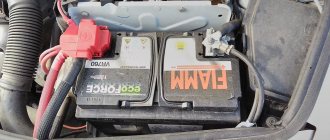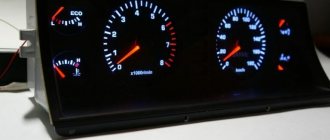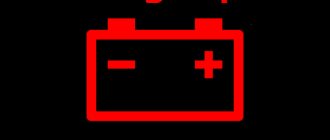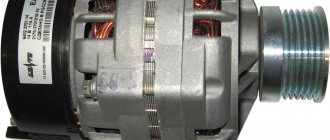Information site about energy storage devices
A car battery is a storehouse of electrical energy, the renewable supply of which occurs due to an electrochemical reaction in several cells. Each bank provides equal amounts of energy. The elements are connected in series, the voltage in the battery is equal to the sum of the resulting potential differences of all banks. If one element fails, the battery becomes unusable. How to find out the cause of the malfunction - is the bank shorted in the battery or is there an open circuit?
Battery banks are shorted - symptoms
Here is a classic lead acid battery consisting of 6 cans. Each of them is composed of pairs of oppositely polar plates. Their contacts are collected into a common collector, connected in series and connected to the cover with two terminals. Modern cans have a different design, but the layout of the cans and cells is the same.
With a series connection, the cell voltages are summed up, and the capacity is determined by the most clogged bank. To charge the battery, voltage is applied to the terminals and current flows through the storage areas. Why do banks short circuit in a lead-acid battery? If for some reason the plates in the jar get closer together, the walls swell, a jumper is created, and the cell is closed. It happens that a contact bridge is created by a piece of crumbled putty or scale.
How can you check if the battery is short-circuited? When measuring the voltage at the terminals, a dip will be detected. For example, a 12 V battery consists of 6 cans with a total voltage of 2.1 * 6 = 12.6 V. The voltage drops to 10.5-11.0 V - look for a closed can.
One of the plates inside the jar is lead, and the other has a layer of active substance applied to it. If the electrolyte level is violated or overcharged, the mass may crumble and short-circuit the plates.
Mechanical damage from the outside can lead to deformation. It is possible that the battery case is swollen, and then internal short circuits of the plates in the banks are possible. This can happen when the electrolyte freezes and from overcharging a maintenance-free battery.
Symptoms of a shorted battery bank are loss of voltage, heating of the battery case. The battery does not charge to 12 volts, is unable to crank the starter, and requires replacement. Sometimes when charging you can hear the smell of rotten eggs - hydrogen sulfide gas is released.
Battery care
Simple rules for caring for your battery will allow you to enjoy instant engine starting both in winter and summer. If the car is idle for a long time, it is better to remove the battery or periodically discharge and charge it. A clean and dry battery, without traces of dirt and electrolyte, reliable fixation of the terminals, clean ventilation holes, timely replacement of spark plugs and engine oil - all this is basic technical auto hygiene. A visit to an auto electrician once a season will help avoid many surprises. Professional battery testers and analyzers, monitoring systems and load banks - all these innovative developments help not only detect faults, but also predict possible breakdowns.
“How to determine a short circuit between the plates in a car battery? What are the signs of a short circuit? What are the consequences of operating a battery with a short circuit? Is it possible to repair a closed can?”
Short circuits between the negative and positive plates can occur as a result of damage to the separator, which is designed specifically to prevent contact between electrodes of different polarities. Also, unwanted contact occurs when sediment accumulates on the bottom or above the tops of lead separator build-ups (dendrites), which can cause the negative plates to bond to the positive ones. Also, a “short circuit” is usually called a breakage of an electrode plate or a breakage of the plates from the jumper holder.
Signs of a short circuit inside the batteries:
a) a decrease in electrolyte density, despite the fact that the battery receives a normal charge; b) rapid loss of capacity after a full charge, high self-discharge; c) low voltage in an open circuit 10.4-10.8 Volts during a short circuit or 11.4-11.8 Volts in case of a break.
Tests after which a battery short circuit is diagnosed:
1) a sharp drop in voltage below 9-10 Volts, sometimes down to 0 Volts when tested with a load plug. What is important is the fact that the battery “does not hold” voltage, i.e. the voltage “drops”; 2) boiling of the electrolyte in a closed jar during testing with a load fork. If the battery is without plugs and boiling cannot be seen, then it can be heard (gurgling) by putting your ear to the case; 3) boiling of the electrolyte in a closed jar, or “boiling” in all jars except the closed one, while applying a charging voltage of 14.4 V
If the battery is severely discharged due to current leakage through the short-circuit bridge, then it must be pre-charged before testing. Sometimes the short circuit bridge (usually at the initial stage of its formation) has a sufficiently high resistance and therefore the battery does not quickly discharge. Then the above tests will not “show” the presence of a short circuit. In this case, a sign of a short circuit will be that the battery will lose its capacity within 1-3 days after being fully charged. Charged - left for a day - measured the voltage, if the voltage is below 11.8 Volts, it means a short circuit or a broken plate!
If a short circuit between the plates or a plate in the battery bank is torn off is confirmed, it must be replaced. And although the Internet is replete with “magic” advice that you need, for example, to drop the battery on the floor from a small height (with the hope that the jumper will fall off) or apply a powerful current for a short time from a source of 50-200 Volts, practice has shown that a closed bank can be repaired and still cannot be restored, since the SEPARATOR is TORN, and even if the short-circuit bridge is destroyed, a new one will grow, because the hole in the separator has not gone away.
You can check the battery for a short circuit yourself, having a load plug at hand, or you can use the services of a service and diagnostic center, which are provided by Oil-Ok technical specialists.
Dear visitors! If you wish, you can leave your comment in the form below. Attention! Advertising spam, messages not related to the topic of the article, offensive or threatening in nature, calling for and/or inciting ethnic hatred will be deleted without explanation.
Signs of a shorted battery bank
Since charge is being redistributed inside, the battery case heats up, which is one of the signs of an internal short circuit. If the battery is serviceable, you can determine the shorted bank during charging. At the moment the voltage rises, the plugs on the cans are open, hydrogen is released from them, and the cans boil. If one does not show signs of life, it is closed. You can check and find the cause of undercharging of the battery in a ventilated area or outside.
If a voltage drop occurs in a maintenance-free battery, the device does not charge to operating voltage, as you can determine if the bank is shorted, or for another reason. Experts advise closing the contacts for 1-3 seconds. A copious discharge will begin from the non-working jar.
Even a maintenance-free battery allows you to see the electrolyte level in the jars through the translucent walls. Signs of a closed jar will be a reduced level of electrolyte - it boils away, sometimes a noticeable change in color to black.
What to do if the battery boils while charging
When the battery boils 5 or more hours after the start of charging, and gas formation occurs evenly in all compartments, you just need to control the process and stop it in a timely manner . The automatic charger will adjust the settings and turn itself off. When charging in manual mode, you need to prevent excessive boiling by reducing the charge current.
almost immediately when charging the battery , this is a sign of a battery malfunction or an incorrectly selected charge voltage or current . The most common causes and remedies for unwanted boiling are listed in the table:
| The reason for intense boiling of the battery | Why does the electrolyte boil when charging? | What to do if the battery is boiling |
| Overcharge | Excessively high voltage or current, charging time exceeded. | Reduce the voltage or current, or disconnect the battery from the charger if the electrolyte density has reached 1.28 g/cm³ and remains at this level for several hours, and the voltage at the terminals without load is 12.7 V. |
| Short circuit | Due to a short circuit of the plates in one or more compartments, overcharging occurs in the others. | Disconnect the battery from the charger, find the cause of the short circuit, and eliminate it. To restore the charge evenly in all compartments, the battery will first need to be discharged, for example, using a car lamp. |
| Sulfation and destruction of plates | The precipitation of insoluble lead sulfate crystals on the plates leads to a decrease in their active area. This, as well as the destruction of the plates, reduces the overall capacity of the battery, resulting in a charging current higher than necessary. | To desulfate the plates, it is necessary to recharge with low or pulsed currents. If the active plates are destroyed, only replacing the battery will help. |
| Low electrolyte level | The level decreases due to the transition of the water contained in it into a gaseous state, as a result of which the concentration of sulfuric acid and the density of the electrolyte quickly increase. | It is necessary to add distilled water to the jar and continue charging. |
How to identify a closed cell in a battery
Technically, you can determine a closed bank by measuring the voltage on each bank separately with a voltmeter. To measure the voltage on each bank you need to use a load fork. Under load, the voltage of the can below 1.7 V indicates its defect.
The most reliable testing method is carried out on a completely discharged battery. The battery should produce a voltage of 12 V. The indicator is less by a number that is a multiple of 2 and will determine how many cans have become unusable. In the future, you will need to determine why the bank closed. If the battery is expensive and new, less than 3 years old, it can be revived. But for this you need to have plumbing skills, tools and follow safety precautions.
Reasons for the short circuit of cans in the battery
The main problem is failure to follow the operating instructions for the car battery. Closely spaced plates, active putty on the gratings, are precisely designed to work under the flood, with voltage within the permissible limits. The crumbled mass, sulfation, and a sharp blow to the body are a prerequisite for the contact of the plates with opposite charges. If one bank is overloaded, it will discharge faster, become sulfated, and the first one will fail.
What should I do to prevent the battery from shorting out and to keep it working for a long time? Keep the battery clean, avoiding unnecessary self-discharge currents. Do not leave a discharged battery for a long time without recharging. In the cold, a discharged battery will freeze because it contains a weak electrolyte. Often, just because of 1 cell of battery, you have to recycle the entire battery. There are several reasons why it can close:
- Factory defects are a warranty case.
- Strong blow to the body.
- Chronic undercharging and overdischarging is the most common cause of malfunction.
Why is this happening
The question logically arises: why does one or another bank sometimes short out in a starter-type car battery?
This is mainly due to the actions of motorists themselves, who simply do not follow the instructions for operating power supplies prescribed by the manufacturer.
The plates are located quite close to each other, but at the same time separated, which ensures stable occurrence of electrochemical reactions. But if the operating rules are violated, the plates begin to crumble, the electrolyte level drops, and the oppositely charged plates come into contact with each other.
There are some reasons why the starter battery may short out. But not all of them are related to car owners:
- Manufacturing defects. It is possible that a short circuit in the battery plates may occur due to the fault of the battery manufacturer. These reasons do not appear as often if you buy batteries from trusted companies. But there is still such a possibility. The manufacturer must be responsible for the consequences, since the shorting of cans as a result of a manufacturing defect is a warranty case.
- Physical blow to the body. This is possible in collisions as a result of serious accidents. As a result, the plates shift and a short circuit occurs.
- Chronic overcharging and undercharging. It is this reason that occurs in practice more often than others. Mostly, motorists use a battery that is in a constant state of undercharging. This provokes sulfation and shedding of the plates with all the ensuing consequences. Constant overcharging is possible due to problems with the generator, diode bridge and voltage regulator.
Regardless of the reasons, further actions can be divided into 2 options. This is either recycling the battery and buying a new battery, or trying to restore the battery and extend its service life.
Recovering a shorted battery bank
Once it has been possible to understand that the car battery banks are shorted, it is necessary to evaluate the work to restore the cell and compare it with the purchase of a new device. If more than one can is shorted, there is no point in wasting time and effort on repairs. How do you know if there are still jumpers in other elements? They can appear if the layout of the case is disturbed or the connections are loosened.
Step-by-step instructions on how to restore a shorted battery bank.
- Identify a non-working jar based on the listed characteristics.
- Extract the electrolyte using special means, working in glasses and rubber gloves.
- Cut the plastic around the top of the cell.
- Disconnect the jumpers with adjacent elements and carefully remove the package of plates, rinse them from acid.
- Determine the location of the short circuit - a piece of metal, a bent plate, remove sediment at the bottom.
- Place the structure in place as it was, fill in the electrolyte, and secure the lid with glue.
- Fully charge the battery.
So what should you do now? Can you restore it yourself?
For a simple driver (especially if he is a beginner), it will be difficult to restore, I would even say impossible - it’s better to hand over and buy a “new” one.
But for the “Kulibins” whose hands are itching, there are small instructions for restoration. Just be careful, there is acid inside!
SO, what we need to do:
1) We determine a non-working, closed jar (total voltage is about 10 - 11 Volts, there are no bubbles when charging, it is dark inside).
2) We drain the electrolyte from it.
Video
It’s better to see once how specialists eliminate the consequences of shorted cans. How to restore a shorted battery bank, watch the video.
One of the important elements of a car that requires checking is the battery, or battery. The serviceability of the battery and its performance are very important, since it is thanks to the battery that the car starts, and all systems of the car are powered by it: low and high beam headlights, media system and much more.
Content
If you have already met with the seller and want to be sure that if you buy a car, the first thing you will have to do is run headlong to the store for a new battery, which usually costs more than 10 thousand rubles, then you have several ways to check the battery by car:
- Inspect the battery externally;
- Measure the voltage on the battery with a multimeter;
- Check the battery with a load fork;
- Check the electrolyte level in the battery.
We will consider each question in detail, but we immediately note that the fourth option, with checking the electrolyte level, is only available for serviceable batteries. But one way or another, there are a number of methods for checking a car battery for performance, and in this article we will look at them.
External inspection of the battery
You met the seller and have already walked around the car, seeing how clean and beautiful it is. It's time to look under the hood, you lift the lid and see the usual contents of the engine compartment, the engine and numerous systems that keep the car running.
In most cases, here, in the engine compartment, there is also a battery - a rectangular box with electrolyte inside, to which two wires are connected - positive and negative. These wires go to the distribution block, and from this massive electrolytic “battery” the entire machine and all its systems are powered with electricity.
Even if you don’t understand anything about cars and went for an independent inspection rather as part of a formality, you can still determine by the appearance of the battery what condition it is in.
During an external inspection, attention should be paid mostly to the integrity of the elements, and whether the battery itself and contacts are clean. There are a number of external factors, the presence of which immediately indicates the need to replace or at least clean the battery.
- Dirt on contacts. In order for the battery to work, both contacts connected to it by wiring must be clean. If the contacts are dirty, this indicates that the battery is not new, and dirt will interfere with the correct operation of the contacts.
- Oxidation of the terminals - foreign deposits can be seen on the battery terminals with the naked eye - this is oxidation, which in most cases is associated with electrolyte leakage. Electrolyte is an acid that is found inside the battery. If it spills and gets on the contacts, it can lead to poor battery performance and a reduction in the contact area.
- Cracks on the case - the battery itself should be intact. The plastic box containing the electrolyte must not be damaged. This is also clearly visible without additional equipment and in good lighting.
- Dirt, dust, electrolyte leaks - all this is removed with a rag, and the car should not be allowed to drive with a dirty battery, since the conductive deposit will contribute to its rapid discharge and deterioration of performance.
In addition to the external inspection, you can start the car engine. A cold start will be especially indicative if the engine has not been started for a long time and it is cold outside. If the car starts easily, the battery is in order, but if it does not start or starts with difficulty, the headlights shine dimly, and the instrument panel is also not brightly lit, then the battery should be changed. Or, at least, check it with instruments, which we will discuss below.
Battery leakage detection
Causes and Symptoms of faulty spark plugs and ignition coils. Signs of faulty ignition coils
- Remove the “-” terminal from the battery
- We connect one of the ammeter probes to the “-” battery
- Another on the removed wire (polarity on the digital multimeter does not matter)
- Disconnect the positive terminal from the battery
- Connect the ammeter with the negative terminal - to the contact terminal of the car
- Positive terminal - to the battery
- Prepare the car for testing (turn off the radio, side lights, interior lighting, etc.)
- After a minute, connect the ammeter to the open circuit and take readings. (the peculiarity of car alarms is that they become armed no earlier than after a minute)
- As we saw the leakage current on the ammeter, we begin to pull out and put back the fuses and relays in order.
- It will become clear which circuit is leaking when the current returns to normal.
Measuring voltage with a multimeter
If you do not want to check the condition of the battery “by eye”, or simply want to have accurate results in numerical terms, you will need a device such as a multimeter.
So, how to check a car battery with a multimeter: the device itself has two probes, one of which is red and the other black. In order to measure the voltage on the battery, you need to put the multimeter in measurement mode and place the red probe against the “positive” terminal, and the black probe, respectively, against the “negative” terminal.
The procedure is carried out on the battery terminals without load. If the battery is properly charged, the result on the device will be about 12.6-12.9 volts. This is the normal voltage that should be present on a fully charged battery. If you mess up the colors of the probes, the number will be the same, it will just be displayed with a minus sign.
If the engine is running, then you can also check the operation of the battery with a multimeter, but in this case it will be checked whether it is working together with the generator, as well as the serviceability of the voltage regulator. When the motor is running, the readings should be slightly higher - from 13 to 14 volts. If the indicator is lower, this will mean charging problems for the battery, and if the indicator is higher, the process of water electrolysis will begin.
There is a method to determine the degree of battery discharge by voltage. Voltage 12.5 - says that the battery is 90% charged, voltage 12.1 - 50%, and 12 - 10 percent. Although the method is approximate, it is proven.
Structure
A modern battery, just like 30–40 years ago, has a very simple structure. It is usually divided into six sections or so-called “cans”, each of them contains lead plates, which are laid in series with a dielectric. Some are “positive”, the other part are “negative”. This structure is filled with electrolyte, in our case it is a mixture of sulfuric acid and distilled water.
These 6 banks are connected in series and give us a certain voltage. It may differ from battery charge and discharge. Typically, a charged battery has a voltage of no more than 13V when charged, and a little less than 10V when discharged (I don’t advise you to discharge more than that, because deep discharge also doesn’t do anything good).
To charge the system, you simply need to apply electricity to the electrodes, so it will begin to accumulate in each of the cans.
This is a basic idea of how a battery works, watch a short video for a more complete understanding, and move on.
Checking the battery with a load fork
The load fork is a very precise tool, but is rarely used in “manual” use, as it is used mainly in service stations. The beauty of this method of verification is that thanks to it an absolutely accurate result will be known.
The load plug works in a similar way to a multimeter: it is also connected to the battery terminals, but produces a short circuit current. As we already said, without load the indicator should approach 13 volts. The load fork imitates the operation of a starter, which is why the voltage “sags” at the moment of use.
The drop should be no more than 9 volts. Otherwise, it will mean that the battery is very discharged. After removing the load, the indicator again “rolls back” to its original value. If under load the voltage “sags” to 5 or even 3 volts, this means that the battery will not be able to start the car engine.
It is recommended to think about changing the battery even if the voltage when using the load plug drops below 9 volts.
An extremely important note: the load plug supplies approximately 200 amps of voltage to the battery and is not recommended for use in low temperatures. The ideal conditions for “field” use of this device is a temperature of +20-25 degrees Celsius.
If you apply voltage to a cold battery, there is a risk of severely discharging it.
Where to check the battery status
The best option for checking the condition of a car battery is professional testing of all parameters in a car repair shop. The presence of all the necessary equipment will allow us to make an unambiguous conclusion about the possibility of resuscitating the battery.
The working life of any battery is not unlimited and depends on operating conditions. An average annual temperature of +4°C with a mileage of 30 thousand km/year will allow the battery to last a little more than 2 years. Annual mileage of up to 20 thousand km/year extends the battery life to 3 years.
To check the battery operation, it is better to contact a car repair shop.
Predominant driving on broken roads, constant shaking and vibration make it advisable to purchase a maintenance-free battery to avoid short circuits. For trouble-free starting of powerful Japanese SUVs with installed subwoofer, air conditioning, heated steering wheel, seats and windows, you will need a battery 5-10 Ah more powerful than recommended by the manufacturer.
Checking the electrolyte level in the battery
Another convenient and reliable method, which, however, is only suitable for checking serviced batteries, is checking the electrolyte level. The method is a little more complicated than the previous ones, but it gives a good idea of the condition of the battery and tells you what’s inside it.
First, remove the battery and completely clean it of dirt. Let us remind you that it is better to do this with a rag; dirt and minor corrosion can also be cleaned off using an ammonia-based glass cleaner.
Next you need to open the two filler plugs. They need to be easily pryed with a screwdriver and unscrewed; six filler holes are hidden under them. The electrolyte level in them is checked by eye and can be seen with a flashlight. If the liquid level is the same everywhere, then everything is in order, if somewhere the liquid does not cover the plate, you need to add distilled water.
In general, this procedure must be carried out regularly, since each time the battery is charged, the electrolyte decomposes in small proportions into hydrogen and oxygen. Without regular maintenance, the battery will simply fail.
The norm is considered to be a level exceeding the height of the plates by about one centimeter, or below the neck of the filler hole by three millimeters. If necessary, it is worth adding distilled water to the battery being serviced, but we remind you once again: if the battery is marked “maintenance free”, or the manufacturers of this particular battery model do not recommend adding distilled water to it, you can only resort to the previous testing methods and, if necessary, replace the battery.
Knowing how to properly check a battery is important when buying a used car. Often, car sellers want to save money on small things, including selling a car with a dead battery, which can lead to negative consequences for the new owner. Always be alert and fact-check what the seller says about the health of your car.
And don't forget to check the car's history before purchasing. This can be done using the Autocode online service using VIN or state registration number. number. The system checks the car in more than 12 official databases: traffic police, EAISTO, RSA, taxi and bank registers, Federal Tax Service, Federal Customs Service and others. From the report you will find out: actual mileage, whether there are traffic police restrictions, compulsory motor liability insurance data, customs history, history of fines, participation in road accidents and much other important information.
If you do not have the opportunity to go for an inspection or you simply doubt your experience, order the Autocode on-site inspection service. An expert will come for an inspection and conduct a comprehensive diagnosis of the car, leaving no doubt about your choice of vehicle.
Modern batteries can last up to 10 years before needing to be replaced. Unfortunately, even such elements cannot be completely protected from premature failure, especially as a result of sulfation of plates or shorting of cans. The last problem is especially relevant if the battery was operated in difficult conditions.
What could cause the battery bank to short circuit?
If the battery in use has already served the period recommended by the manufacturer, then shorting the bank is simply one of the reasons for the “death” of the battery. In a new battery, such a problem most often occurs due to defects. If you have a receipt for the product and a valid warranty period, you can contact the store where the battery was purchased.
The bank can also be shorted as a result of improper use of the battery. For example, if it was not securely fastened in its original place, but the car was driven at high speed off-road, then from constant impacts and shaking the active mass of the plates may crumble, and a short circuit will occur.
If the battery is dropped while being carried, then the internal elements may be damaged, which will also short out one or more sections. Side impacts are no less dangerous, so extreme caution should be exercised, because in addition to failure, acid may leak when the housing is depressurized.
Most often, the short circuit of the cans occurs due to the fact that they do not have time to fill the electrolyte in time. After all, if it falls too low, the plates will be exposed and crumble. Accidentally connected positive contacts to ground can also manifest themselves in the form of destruction and shedding of plates, which sooner or later will lead to a short circuit.
Battery malfunctions. Elimination. Repair
Battery malfunctions manifest themselves in the fact that it stops supplying the required current to the load or that mechanical defects, cracks appear on it, and electrolyte flows through them.
Cracks
Cracks can occur due to mechanical stress or impact. But most often they occur after the battery fails. A well-charged battery can withstand low temperatures down to -45 degrees. But if it is practically discharged, it will freeze at -15. Regular maintenance will protect against freezing.
The inability of the battery to perform its functions, that is, to power the load with mechanical integrity, can be caused by the following reasons:
Deep discharge
As I already wrote, severely discharged batteries cannot be recharged if the charge is controlled by the voltage on the battery (for example, in a car). This fault can be easily eliminated by charging the battery with a fixed voltage with current limitation or charging with a fixed low current (3% of the rated capacity) with manual density control every hour. We charge the battery to a density corresponding to a full charge. After such recharging, the battery is usually (if it has not deteriorated due to deep discharge) again ready for use in the automotive system and will be charged from the generator.
There are times when only one, two or three banks are severely discharged. So, if the contacts of each bank are pulled out, it is better to charge each discharged bank separately with a fixed current with density control. If there are no contacts, you can charge the entire battery with a fixed current with density control. But for this you will need a charger of 24 volts or more. Otherwise, you will not be able to supply the required fixed current through the well-charged canisters. Acid batteries generally withstand recharging well under a variety of conditions. Firstly, you need to regularly add water to already loaded cans; it will decompose in them. Secondly, charging must be done with a small current. Once fully charged, the can begins to heat up, it can no longer store energy and dissipates whatever it receives as heat. Cans should not be overheated. If the current is small, this will not happen.
As a result, all banks will charge fees gradually. Some before, some after. Then the battery can be used as usual.
Closing the jar
Due to improper use or simply wear, the plates in the jar may close. In addition, they cannot close completely except through a thin porous oxide bridge. The bank closing sign has such an effect. We charge the battery as described above. But the density does not increase in one or more banks. They cannot be charged. This is closure. Another option is that you can charge, but after a day the density of the electrolyte itself decreases again. Usually this is a sentence. The battery can be transported with lead or cast iron weights. But if you have access to the contacts of a closed bank, you can try to save the bank. The chances of success are slim, but what are we missing? Let's take a DC inverter welding machine. We do not include it in the network. We connect banks less to less, more to more. We set the current to 250 A. We put on safety glasses and clothing (there will be a bright spark and possibly electrolyte splashes). All battery spark plugs must be screwed in, otherwise a spark may cause an explosion of gases in the battery. We take a welder and move as far as possible; we put a protective partition between us and the battery. The battery may actually explode. Turn on the welding machine for a short time. You can try turning it on several times. Large current can burn out the short circuit and reset the bank. After the procedure, if the battery is intact, you can try to charge it and find out if it worked.
Recharging, changing the polarity of the can
This effect can be achieved if regular maintenance is not carried out. The bank will be severely drained and you will continue to use the battery. Other banks supply current, and it begins to charge with reverse polarity. Remember that the material of both plates is almost the same. This problem can also be cured by deep discharging one or more cans, charging with a small fixed current with constant density control and adding distilled water to healthy cans.
Unfortunately, errors periodically appear in articles; they are corrected, articles are supplemented, developed, and new ones are prepared. Subscribe to the news to stay informed.
Sulfation Causes of sulfation, loss of capacity of a car battery. Know more.
I have a fairly old battery. He behaved normally, as expected. But in the last month (July) after heavy rain, it was thrown off while being installed on the car. The fact that it is discharged is nothing strange - the car has not been used for a long time. Another thing is unclear. Voltage at the terminals (the battery was connected to the on-board network, i.e. the grounding switch was closed, but bare Read the answer.
While charging the 12V battery, it supplied a voltage of 24V and a current of about 7A for about 5 hours. The battery naturally discharges. What happened to it (sheet metal short circuit, layer collapse)? Can I be cured? Read the answer.
Goodbye! I have a question for you, a new acid-acid battery for motorcycles, I suspect that there is a crack in the bridge between the embankments. Is it possible to cure a battery without disassembling it, using some “chemical” method? Thanks for the answer. Read the answer.
Hello. I bought a new battery and started pouring electrolyte into the first jar, the second was full. Completed the third, completed the fourth, etc. Can banks communicate with each other? I took it to the store and they said maybe. And I doubt something. Thank you. Read the answer.
My battery usually has five cells charging and one cell in the center not charging at all. I charged the battery with a current of 2.5 amperes at first for 24 hours, there was no positive result, then again the same thing, but the bank did not charge. The car starts well. What could this lead to? Read the answer.
Hello, tell me why in a new battery, when fully charged, the density is somewhere around 1.17? But it works properly, no problems arise (we measured the density on a charged battery and in a warm room where the battery was heated for several days). Thank you. (Quote from the first question). The fact is that I am not sure that the electrolyte in the battery was initially filled normally. Read the answer.
Hello, why can't you change the polarity of the battery? Having charged a completely discharged battery, I reversed the polarity, the battery was charging, but quickly discharged and became + - and vice versa, how is this possible? Read the answer.
Insulation to retain heat. Warm-up, typical mistakes, how to do it correctly.
Injection engine design. Injection faults. Injection engine design. General operating principle. Overview of components and faults
How to deal with knocking in the car. What is detonation? How this manifests itself is evident in the internal combustion engine.
Detonation and octane. Effect of additives. Knock sensor. Operating principle. Ignition time. Octane additives.
Faulty motor? Troito. Decreased potency. Compression measurement. Review of car engine malfunctions. Troito / double Loss of power.
Selection of an analog generator, search for a suitable aftermarket machine. How to choose a cheap (non-original) replacement generator for a car
Signs of a shorted battery
If a fully charged battery does not start the engine, while the wires are properly connected to the terminals and there are no electrical problems, then this “behavior” is almost always associated with a short circuit in the bank.
Excessive heating of the battery may also indicate damage of this type, because if one compartment fails, entire cells will be subject to increased load.
Symptoms such as reduced starting current power and high battery temperature often leave no doubt that one of the batteries is inoperative, but to confirm the “diagnosis” it is advisable to conduct a series of experiments, including using measuring instruments.
Checking the battery charge when measuring electrolyte density
This method of checking is quite useful before the onset of winter. A decrease in ambient temperature reduces the density of the electrolyte. Thus the charge also drops. Low density increases the risk that the car engine will not be able to start.
To check the charge of a car battery, you need a special device - a hydrometer. The sequence of actions is as follows:
- 6 caps of battery cans are unscrewed.
- The hydrometer is placed inside the jar. And you need to wait until it is completely filled with electrolyte.
- It is pulled out and over time the float will indicate the current readings.
Using a car at low negative temperatures with a discharged battery will lead to freezing and disintegration of the lead plates.
In the table you can see at what sub-zero temperature, depending on the density of the electrolyte, ice appears in the battery.
| g/cm3 | 1,10 | 1,11 | 1,12 | 1,13 | 1,14 | 1,15 | 1,16 | 1,17 | 1,18 | 1,19 | 1,20 | 1,21 | 1,22 | 1,23 | 1,24 | 1,25 | 1,28 |
| °C | -8 | -9 | -10 | -12 | -14 | -16 | -18 | -20 | -22 | -25 | -28 | -34 | -40 | -45 | -50 | -54 | -74 |
As you have already noticed, even a fully charged car battery will freeze at a temperature of -74 degrees, and with a capacity of 40% it will freeze at -25 degrees. And with a low charge, up to 10%, it will not be possible to start the engine even in mild frost.
How to check for a short circuit
The easiest way to check for a short is a serviced or low-maintenance battery. To do this, just unscrew all the covers and put the battery on charge. At some point, good jars will begin to boil, while nothing will happen in a closed one. By the way, under load, on the contrary, it is the closed can that will boil.
If you then measure the density of the electrolyte in each jar, it will turn out that the normal ones will have a normal value (
1.27), and when dead the float will float to the very minimum value (slightly more than one). In addition, when starting the engine, there will be a voltage drop of up to 9 volts.
Note! Indirect evidence will be a white coating that can be observed in the jars through the holes; this is sulfation.
In maintenance-free batteries there is no open access to the banks, so determining a short will be a little more difficult. The easiest way to determine this is by the voltage drop to 9 volts when the engine starts. This will not be enough to start and the engine simply will not start. When charging, the battery voltage will not rise above 10.7 Volts.
Types of car batteries
If it is possible to regulate the level and density of electrolyte, batteries are divided into 4 types:
- serviced (low antimony);
- low-maintenance (antimony lead);
- maintenance-free (calcium);
- hybrid.
The most popular batteries are low maintenance. The rarest and most expensive are hybrid ones. Maintenance-free calcium batteries are also expensive, are not suitable for all types of transport and require special operating conditions. Maintained batteries are practically not used anymore.
Is it worth trying to repair the battery?
If the battery is under warranty, then it should be returned to the store where it was purchased, as this may be a manufacturing defect. They will have to conduct an examination and if it is determined that the battery failed through no fault of the car owner, it will be replaced with a new one.
In old batteries this is an “age-related disease”. In this case, the most correct decision would be to scrap the battery and purchase a new one. In the event that the malfunction is caused by crumbling active substance, the battery can be restored.
If the body is made of light plastic, then it is easy to notice an accumulation of dark mass in the lower part of the closed jar, which should be removed. Efforts to restore the battery by flushing the jar from debris are justified only if the remaining battery cells are in fully working order.
Important! If the bank is shorted, then it is better not to restore the battery and purchase a new one, since it will still not be possible to return the former capacity, starting current and voltage.
Write-off process
The battery is transferred to a recycling organization.
This is done as follows. The condition of the part being written off is checked in accordance with RD-3112199-1089-02 or the instructions in force at the enterprise. A battery write-off act is drawn up. Its sample is in RD-3112199-1089-02 in Appendix No. 3.
The battery is handed over to a recycling company. In accounting, on the basis of the write-off act, the part is written off from off-balance sheet account No. 9 and information about the new spare part is recorded on it.
How to restore a shorted battery
Before attempting to repair the battery yourself, you must take the necessary precautions. It is advisable to carry out all work in a well-ventilated area, and to protect against sulfuric acid use a rubberized apron, gloves and goggles.
The product can be repaired in the following sequence:
- Remove the battery from the car.
- Understand which section is not showing signs of life.
- Mark the boundaries of the can on the battery lid with a marker.
- If the battery is serviceable, then use a rubber bulb or hydrometer to remove the maximum amount of electrolyte from the jar.
- Using a hacksaw blade, cut down the previously marked section of the lid; after cutting, access to the plates will open. If a maintenance-free product is disassembled, then at this stage the liquid should also be removed from the opened compartment.
- To remove a damaged battery, you need to saw off the jumpers connecting it to other banks. For this purpose, you will need to lightly saw the plastic covering these elements, and then carefully separate the lead elements using a hacksaw blade.
- Carefully, using small wire hooks, the block of plates and separators is pryed up and removed from the battery case.
- Then you will need to prepare a plastic container with distilled water, into which the removed part is dipped several times.
- The jar should also be thoroughly washed with distilled water.
- If the plates are not badly damaged, then they can be installed back, otherwise it is necessary to select a similar element from another battery of the same capacity.
- When installing a “native” or borrowed can, the polarity must be observed. Only in this case can you hope for normal battery operation after repair.
- Lead parts are soldered with a powerful soldering iron. This tool can also be used to install a previously cut piece of plastic cover. If the battery is maintenance-free, then before reliably closing access to the jar, a sufficient amount of electrolyte is poured into it. In serviceable batteries, this procedure can be performed after the soldering work has been completed.
The repaired battery should be charged. Then the operation of the product is checked under load. If a fully charged battery copes with starting the engine, then, with high-quality metal soldering, such a battery can work for several more years without any complaints.
Note! If you manage to restore the battery, it is not recommended to install it on the car; it is better to use it somewhere on the farm as a backup power source.
Oxidation of pole pins
Electrical wiring terminals are attached to the pole pins. When in contact with moisture and air, they oxidize. Which leads to weak contact. When heavy loads occur. For example, when the starter rotates. Especially in cold weather. Terminals and pins may melt or even burn out.
To get rid of oxides, you need to remove the terminals. Spray the pins and terminals with water. A chemical reaction will occur that will dissolve the plaque. Anything that cannot be washed off with water must be thoroughly cleaned and wiped dry. Afterwards, install the terminals tightly and lubricate them with technical petroleum jelly. Ordinary lithol will also work, the main thing is to limit the access of moisture to the surface of the terminals and pins.











